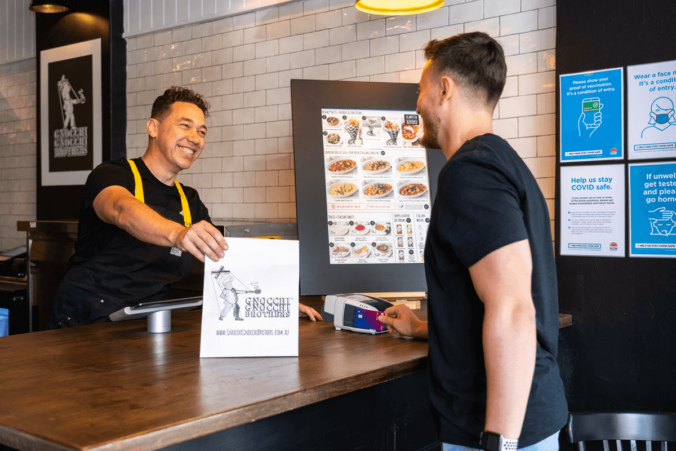What are the benefits of upgrading to a new EFTPOS machine?


Whenever a customer makes a payment with their credit or debit card (including devices such as mobile phones and smartwatches), your business incurs a fee for processing that transaction. Exactly how much depends on the card, as they all incur different fees.
As a business, it’s your choice whether you want to absorb these processing costs or recover them by passing some or all of it onto the customer in the form of a surcharge.
So you can decide whether surcharging is right for your business, we’ve compiled a guide with all the ins and outs you should know about the money-saving measure. Covering what surcharging is, how it works with Tyro, the benefits of surcharging, and your responsibilities if you choose to surcharge, let it be your guide to all things surcharging.
A surcharge is a fee that you, as a business owner, can apply to your credit or debit card transactions on top of the advertised retail price, in an effort to cover the cost of accepting those payments.
Essentially, it’s a fee you charge your customers for using cashless payments.
The biggest advantage of surcharging is that it allows you to keep more money in your back pocket. By recovering part or all of the processing cost from your customers, you’ll have more dollars in your wallet that you can stash away for a rainy day or reinvest into your business.
As we mentioned earlier, whether or not you want to surcharge your customers is up to you.
When deciding if you should impose a surcharge, ask yourself the following questions to work out if it makes sense for your business:
If you decide not to surcharge, but still want to keep your expenses down, you could consider including the costs of all business expenses (including transaction fees, rent, equipment etc.) into the pricing for your product or services. If you do decide to impose a surcharge, there are a few things to keep in mind.
If you say yes to surcharging, there are three important things that you need to be across to ensure you surcharge compliantly.
Your cost of acceptance is how much it costs you to accept a particular card type. Therefore, your surcharge can’t be worth more than what it costs you to use a certain payment method.
The Reserve Bank of Australia (RBA) standard¹ states that businesses can only pass on the average cost of what it costs them to accept each type of card transaction. Surcharging more than your cost of acceptance may result in excessive surcharging, which can be investigated by the Australian Competition and Customer Commission (ACCC).
According to the RBA, surcharging calculations can cover:
If you surcharge your customers, it’s an RBA requirement to let them know that you’re doing so. You’ll need to publicly display the cards that the surcharge applies to and, where relevant, display the percentage or amount of the surcharge, via clear and concise signage.
If you’re a Tyro customer, you can download signage to clearly indicate your surcharging rates here
As a business owner, it should be your responsibility to review your cost of acceptance each year. The RBA standard requires you to conduct a yearly review to ensure that your surcharge rates remain compliant as they may have changed over the course of 12 months.
Using your annual statement, as well as any other applicable costs, you must check whether your surcharge remains less than – or equal to – your cost of acceptance, and set your surcharge for the following year based on what you find.
Here at Tyro, we make surcharging simple. We offer an automated surcharge feature, so you don’t have to waste time manually calculating and applying surcharges.
Tyro’s Dynamic Surcharging² allows you to set a surcharge rate across a range of card types via your web-based Tyro Portal, including Mastercard, Visa, eftpos, UnionPay and American Express, JCB, and Diners Club.
It’s up to you what rate you choose to surcharge but you should keep in mind your cost of acceptance for each card type. So you can make a more informed decision on surcharging whilst staying within the boundaries of the RBA surcharging guidelines, Tyro provides your cost of acceptance for you in your Tyro Portal. Tyro calculates your cost of card acceptance by taking an average of the cost of all transactions that you have processed for each eligible card type, over the previous 12 months. We also provide you with the option to include the cost of the machine rental fee into your cost of acceptance.³
Once everything is set, your Tyro EFTPOS machine (except for Tyro Go) is then able to dynamically detect the card presented by your customer and automatically apply the correct configured surcharge, allowing you to recover your fees easily. When Dynamic Surcharging is enabled and customers pay, the Tyro EFTPOS machine screen will display ‘Surcharge may apply’ along with the total transaction amount. Pressing the ‘Info’ button on the machine will display the details of the surcharge rates.
If you’re a Tyro customer and want to know how to enable Dynamic Surcharging, head here.
If you’re a Tyro customer and want to review or adjust your Tyro surcharge preferences, simply log into the Tyro Portal and head to Self-service > Surcharging.
To learn more about surcharging, such as applying refunds (e.g. the surcharge must be refunded too), take a look at the following links.
Australian Taxation Office – GST and surcharging
RBA – Card payment regulations explained
ACCC – Merchant and consumer information
Surcharging is an easy way to cut down on your business’ operating costs, and it can put your mind at ease knowing that the costs of card transactions are automatically recovered through Dynamic Surcharging on your Tyro EFTPOS machine.
1 The RBA’s surcharging standard doesn’t apply to card payments for taxi fares, as this is the responsibility of state and territory regulators. If you accept payments for taxi fares using an EFTPOS machine, please check the applicable rules in your state or territory.
2 Dynamic Surcharging is only available on CounterTop EFTPOS and Mobile EFTPOS machines and excludes eCommerce transactions.
3 You may choose to also apply EFTPOS machine rental costs into your calculation of your cost of acceptance via the Tyro Portal. By default, we do not include your EFTPOS machine rental costs into the calculation of your cost of acceptance.
You may also like
17 Dec 2024 - 2 min read
13 Dec 2024 - 2 min read
12 Dec 2024 - 0 min read
5 Dec 2024 - 2 min read
Australian-based 24/7 support